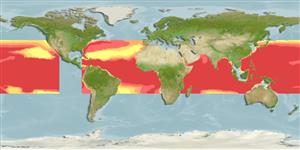>
Myctophiformes (Lanternfishes) >
Myctophidae (Lanternfishes) > Lampanyctinae
Etymology: Lampanyctus: Greek, lampas, -ados = torch + Greek, nykte = night (Ref. 45335).
Environment: milieu / climate zone / depth range / distribution range
Écologie
marin bathypélagique; océanodrome (Ref. 51243); profondeur 100 - 1000 m (Ref. 44036). Deep-water; 42°N - 22°S, 82°W - 109°W
Circumglobal. Eastern Atlantic: Mauritania to Angola. Western Atlantic: isolated individuals to 42°N in the Gulf Stream but generally from 23°N to Brazil. Indian Ocean: between 10°S and 18°S. Western Pacific: Japan (Ref. 559), Taiwan (Ref. 5193), Australia (Ref. 7300), and New Zealand (Ref. 5755). Eastern Central Pacific: near Hawaii, and at western margin of the California Current region (Ref. 31442). South China Sea (Ref.74511).
Length at first maturity / Taille / Poids / Âge
Maturity: Lm ?, range 11 - ? cm
Max length : 12.4 cm SL mâle / non sexé; (Ref. 4479); poids max. publié: 15.40 g (Ref. 126117)
Épines dorsales (Total) : 0; Rayons mous dorsaux (Total) : 14 - 15; Épines anales: 0; Rayons mous anaux: 17 - 19; Vertèbres: 37 - 39.
Oceanic, epipelagic to mesopelagic (Ref. 4066). Found between 475 to over 900 m during the day and between 100-500 m at night (Ref. 4066). Maximum abundance found between 300-500 m at night. Sexually mature from about 11.2 cm (Ref. 4479). Oviparous, with planktonic eggs and larvae (Ref. 31442). Minimum depth from Ref. 4066. Also Ref. 58302.
Hulley, P.A., 1990. Myctophidae. p. 398-467. In J.C. Quero, J.C. Hureau, C. Karrer, A. Post and L. Saldanha (eds.) Check-list of the fishes of the eastern tropical Atlantic (CLOFETA). JNICT, Lisbon; SEI; Paris; and UNESCO, Paris. Vol. 1. (Ref. 4479)
Statut dans la liste rouge de l'IUCN (Ref. 130435: Version 2024-2)
Menace pour l'homme
Harmless
Utilisations par l'homme
Outils
Articles particuliers
Télécharger en XML
Sources Internet
Estimates based on models
Preferred temperature (Ref.
123201): 8 - 18.5, mean 11.9 °C (based on 675 cells).
Phylogenetic diversity index (Ref.
82804): PD
50 = 0.5000 [Uniqueness, from 0.5 = low to 2.0 = high].
Bayesian length-weight: a=0.00562 (0.00323 - 0.00980), b=3.16 (3.01 - 3.31), in cm total length, based on LWR estimates for this species & Genus-body shape (Ref.
93245).
Niveau trophique (Ref.
69278): 3.1 ±0.28 se; based on food items.
Résilience (Ref.
120179): Milieu, temps minimum de doublement de population : 1,4 à 4,4 années (Preliminary K or Fecundity.).
Fishing Vulnerability (Ref.
59153): Low vulnerability (10 of 100).
